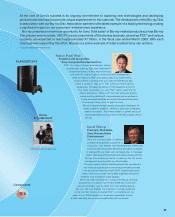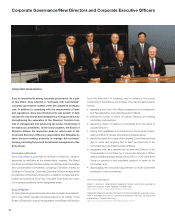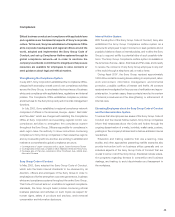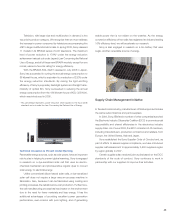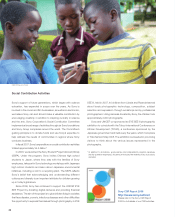Sony 2008 Annual Report Download - page 47
Download and view the complete annual report
Please find page 47 of the 2008 Sony annual report below. You can navigate through the pages in the report by either clicking on the pages listed below, or by using the keyword search tool below to find specific information within the annual report.
Television, with larger size and multifunction in demand, is the
top priority product category. We recognize that we must address
the increase in power consumed by televisions accompanying the
shift to larger multifunctional models. In spring 2008, Sony released
11 models in its BRAVIA series of LCD televisions. The maximum
level of power reduction is 179%* under the energy reduction
achievement rate set out under Japan’s Law Concerning the Rational
Use of Energy, and all of these new BRAVIA models, except for one
model, earned a fi ve-star rating for energy effi ciency.
With the BRAVIA KDL-32JE1 released in July 2008 in Japan,
Sony has succeeded in cutting the annual energy consumption to
86 kilowatt hours, which is equivalent to a reduction of 232% under
the energy reduction standards. By raising the light-emitting
effi ciency of Sony’s proprietary backlight system and the light trans-
missivity of optical fi lm, Sony succeeded in reducing the annual
energy consumption from the 194 kilowatt hours of KDL-32S1000,
which was introduced in 2005.
* This percentage represents power reduction when applied to the fi scal 2008
standards set out under the Law Concerning the Rational Use of Energy.
Technical Innovation to Prevent Global Warming
Renewable energy sources, such as solar power, have an important
role to play in helping to prevent global warming. Sony is engaged
in research on a dye-sensitized solar cell that uses an electro-
chemical mechanism and photosensitive organic dyes to convert
solar energy to electrical energy.
Unlike conventional silicon-based solar cells, a dye-sensitized
solar cell does not require a large vacuum process machine in
fabrication. Also, because it can be fabricated using coating and
printing processes, the cell allows low-cost production. Furthermore,
the cell manufacturing process has less impact on the environment
due to the need for fewer materials and less energy. It has the
additional advantages of providing excellent power generation
performance, even indoors with poor lighting, and of generating
stable power that is not reliant on the weather. As the energy
conversion effi ciency of test cells has registered an industry leading
10% effi ciency level, we will accelerate our research.
Sony is also engaged in research on a bio battery that uses
sugar, another renewable source of energy.
Supply Chain Management Initiative
In the electronics industry, manufacturers of fi nished products share
the same subcontractors and parts suppliers.
In 2004, Sony, IBM and a number of other companies launched
the Electronic Industry Citizenship Coalition (EICC) to promote social
responsibility and shared effi ciencies in the electronics industry
supply chain. As of June 2008, the EICC consisted of 42 members,
including manufacturers, production contractors and retailers, from
Europe, the United States, Asia and Japan.
Sony established the Sony Supplier Code of Conduct and, as
part of efforts to assess supplier compliance, we have introduced
supplier self-assessment to approximately 3,500 suppliers region
by region globally in 2007.
Certain suppliers also received joint audits based on the EICC
standards of the code of conduct. Sony continues to work in
partnership with our suppliers to improve their activities.
45
08SonyE_P40_48_0725.indd 4508SonyE_P40_48_0725.indd 45 08.8.7 2:20:41 PM08.8.7 2:20:41 PM




